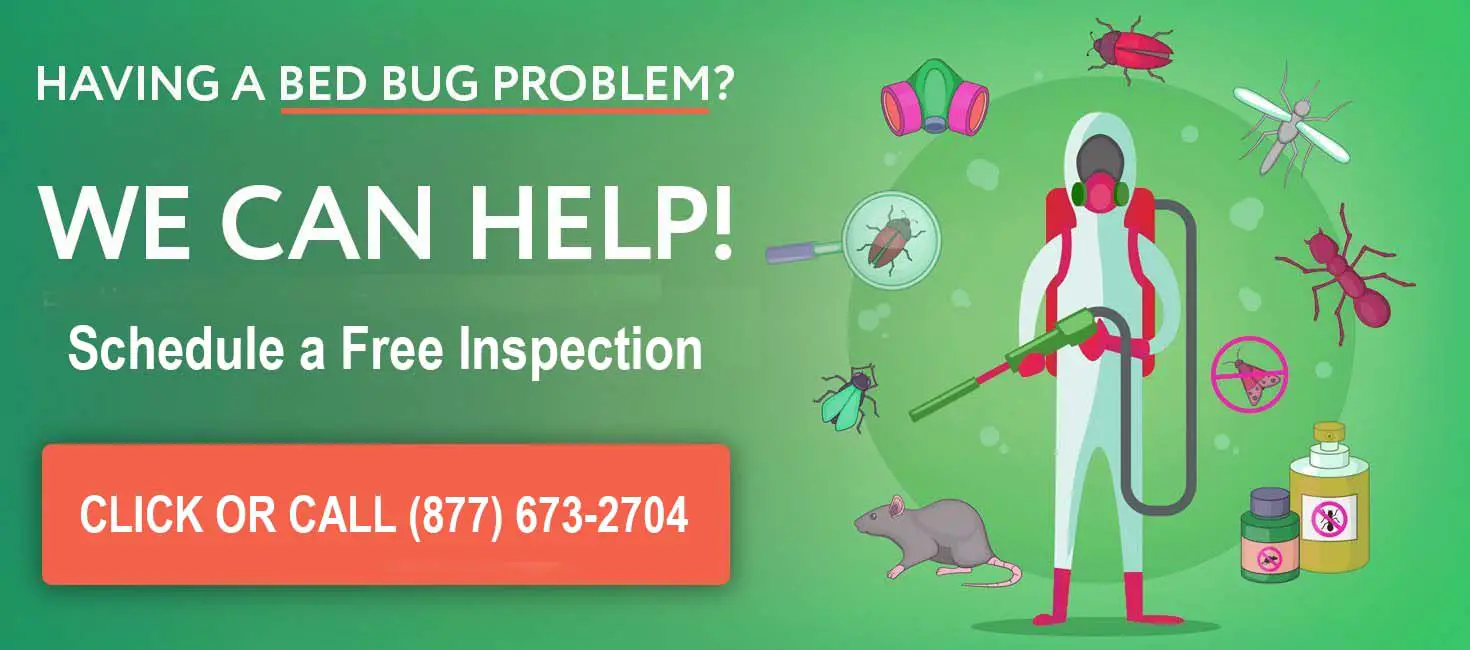"What are bed bugs is the first question most people ask. Bed bugs are insects that many thought were extinct. However, with the increase in global travel, and the banning of pesticides that were effective against bedbugs such as DDT (although they were developing a resistance to it), bed bug infestations have started to grow. These bugs are parasites which feed off of human and animal hosts by inserting a pointed stylet from their head into the skin of the host. They stylet looks for a capillary or vein to take a blood meal. Any skin redness or raised areas that develop, the "bed bug bite" are actually allergic reactions that vary in intensity from person to person. Most people show no skin reaction, which is how two people in a bed can have different skin reactions. Bed bugs do not spread disease, although in some people their bed bug bites could trigger a severe allergic reaction."
Bed bugs were thought to be extinct in the United States. With changes in the law to ban insecticides that could be harmful to the environment, products that killed bed bugs at the same time they killed other insects were banned. In their place, the new breed of insecticides targeted specific insects such as roaches, with bed bugs being largely ignored.
Regarding DDT, the banning of DDT may not have made a difference, as their were reports of bed bug resistance to the insecticide. This is somewhat common in bed bugs as even today some bed bugs that have developed a resistance to the bedbug products being used.
What are Bed Bugs?
The most commonly known insect that falls into this category is the Cimex Lectularius. This insect thrives in temperate environs and it can be found around the globe in warmer tropical climates. This particular pest is known as a parasite, which means that it feeds on a host. They unfortunately prefer human blood, but will look for alternate hosts such as your dog or cat if they cannot find a human.
They can live anywhere there is a host animal such as a birds nests or your home.
Where did bed bugs come from? Mattress and furniture infestations
Bed bugs are believed to have come into the United States from foreign travelers that may have some hiding in their suitcases. When travelers stay in a hotel room or home, the bugs leave the suitcase and inhabit the room where they are staying. They then spread to the next guest.
While some claim that they have been spread to the United States by illegal immigrants, this does not appear to be the case as the incidence of bed bugs in countries such as Mexico is low.
Bed bugs can be easily moved from location to location. They simply hitch a ride on luggage and other items including:
- Mass transit such as buses, planes and planes
- During a public gathering such as in a movie theater
- On the outside of suitcases and backpacks
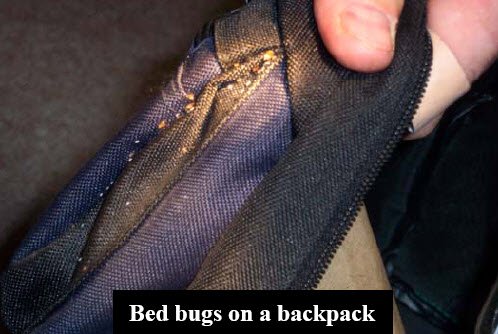 Bed Bug Infestation Hiding In Backpack
Bed Bug Infestation Hiding In Backpack- Infested areas may include; used furniture, bed frames, box springs or mattress seams
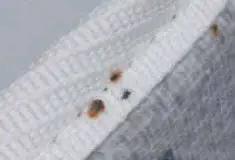 Bed Bugs are Often First Detected by Fecal Matter Left on a Mattress
Bed Bugs are Often First Detected by Fecal Matter Left on a MattressWHERE WILL I FIND BED BUGS IF MY HOME IS INFESTED?
Bedbugs prefer to travel and therefore are good hitchhikers. Typical bed bug hiding places include suitcases, boxes, and footwear to be near a food source. They're elusive, nocturnal creatures.
They can hide behind baseboards as well as in cracks, crevices, folded regions of bedding, around the bed, and adjacent furniture, especially mattresses and box springs. Other common bedbug hiding spots may include electrical switch plates, mirrors, wallpaper and nearly anywhere in the home, vehicle, bus, or any other shelter. Even though bedbugs usually emerge during the night for a meal, they're opportunistic insects and may come out to look for food throughout the day, particularly in heavily-infested areas.
Bedbugs usually require 5-ten minutes to engorge with the bloodstream. After feeding, they proceed to secluded places and conceal for five to ten days. During this period within the bedbug existence cycle, they don't feed but rather digest their meal, mate, and lay eggs. With time, however, they might scatter with the bedroom, getting into any crevice or protected location. They might also spread to nearby rooms or apartments.
Appearance
Bed bugs change in appearance based on where they are in their life cycle. They are hatched from eggs and then move through 5 infant stages which are referred to as instars. The last life stage is adulthood.
Young bed bugs or baby bed bugs are referred to as nymphs. They are almost clear or straw colored and take on a reddish brown appearance after feeding. They will feed every 5 to 10 days, which is required to move from stage to stage.
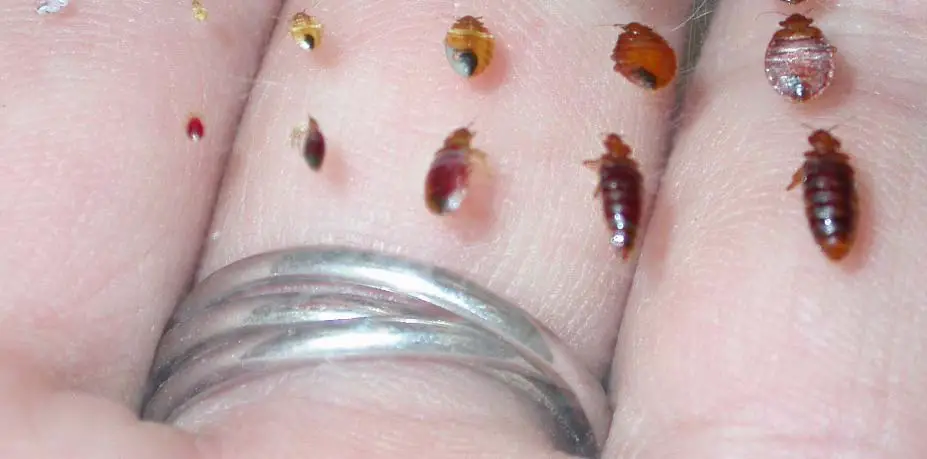 Bedbugs Before and After Their Blood Meal
Bedbugs Before and After Their Blood MealOnce these pests reach maturity they become rust/brown colored. They are flat and oval in shape and while they have wings, they are vestigial, which means that they do not work. t If you look closely at them you will often find that they have bands on their bodies.
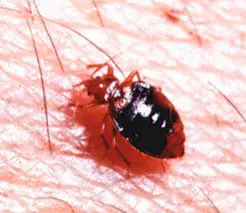 Bed Bug Feeding on Skin
Bed Bug Feeding on SkinOne common myth about these pests is that they are so small that they cannot be seen by the naked eye. They can in fact be seen, the problem is that they tend to come out when you are sleeping, and then hide in credit card sized cracks and crevices during the day.
These pests will normally grow to a length of at least one-eighth to one-quarter of an inch. They cannot fly, but can move quickly across floors or climb walls. To get to a specific location they may climb high and then drop onto the target object such as your bed.
Adults will lay eggs and these eggs can often be found in the crevices of the mattress or in other tight places. A female bed bug will lay 3 to 4 eggs per day.
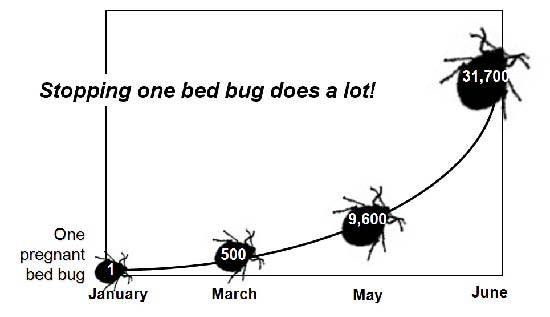 Bed Bug Reproduction Graph
Bed Bug Reproduction Graphbed bug behavioral patterns
These pests do not roam about all night long, as some believe. They are usually far more active about an hour or so before dawn. This does not mean that they will not feed at other times, but generally it is just before sunrise when they choose to do that task.
The pests are attracted to warmth and to carbon dioxide, both of which living humans produce. The feeding bed bug will use a sytlet to get the blood out of the host. When the stylet enters the skin it will inject saliva which contains anti-clotting chemicals that allow the blood to run free the tube which it then uses to suck out the blood. They will normally feed for about five to ten minutes or so and then return to their hiding place.
Infestations usually start in the creases of blankets and mattresses. As the colony of bugs increases they will spread to seams in the mattress, gaps between head boards and foot boards and ultimately to cracks around the room itself. The will spread upward in an apartment building and then to each side of the problem apartment.
In general, they hide within several feet of the source of food. When there is no food they will seek other sources which is why they tend to spread through apartments, college dorms and other close spaces such as a cruise ship.
Can Bedbugs Spread from Apartment to Apartment or Room to Room?
If you live in an apartment, there is a 20% chance that they will spread to an adjacent unit. There is a 7% chance that bedbugs will spread to an apartment above or below the infested unit.
Lifespan
Generally speaking, they like to feed once every week or so. They do not have to feed every night, and they can become dormant for as long as a year, making extermination difficult.
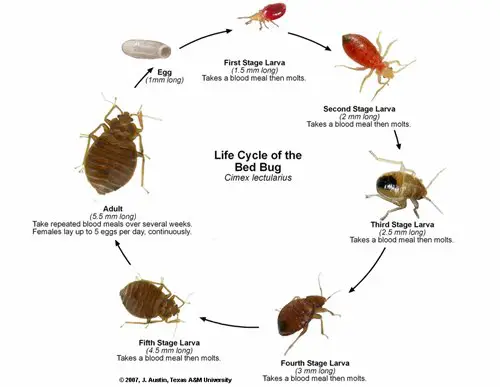 Bed Bug Lifecycle
Bed Bug Lifecycle feeding
It takes a bed bug between 5 and 15 minutes to fully feed. After feeding they go back to where ever they were hiding. They will only come out again when it is time to feed.
If you think you have bed bugs:
- Inspect and Identify: Bring in an expert to confirm that the problem isn't being caused by a bed bug look a like You can also send a sample to IdentifyLLC who will evaluate the bed bug for a small fee. Start by downloading this form (PDF download).
You can also call a local University, Cooperative Extension or county board of health and see if they have a staff entomologist. - Arrange for bed bugs treatment. Either call in a pest control expert or follow these steps on how to get rid of bed bugs. Ask about or use chemical and non-chemical approaches combined.
- Confirm they are gone: This can be done by the bed bug exterminator or purchase inexpensive climbup interceptors for each bed leg. If the interceptor is empty after 2 to 3 weeks, the bedbug problem has been solved.
bedbug bites
Bedbug bites are an allergic skin reaction caused by fluids excreted when the insect punctures the skin. Most people show no skin reaction. People that do have a reaction get small red pus filled bumps on the skin. In chronic cases it can cause skin swelling, wheals or even blisters. Reactions can be seen within 30 minutes or in rare cases days later. Bedbugs do not transmit disease, so bug bites are more of an unpleasant source of discomfort.
There are certain signs that are commonly associated with a bedbug bite:
- Size: Bedbug bites are usually round, red and swollen to a size that is greater than 3/8"
- Appearance: no red spot in the middle of the bite
- Location: bites are usually seen on the neck, shoulders, arms or lower legs
- Pattern: A bite pattern might follow the seam of a mattress where the bugs are hiding and appear as a straight line. They may also be in a triangle pattern (see pictures below).
Typical Bite Skin Reactions
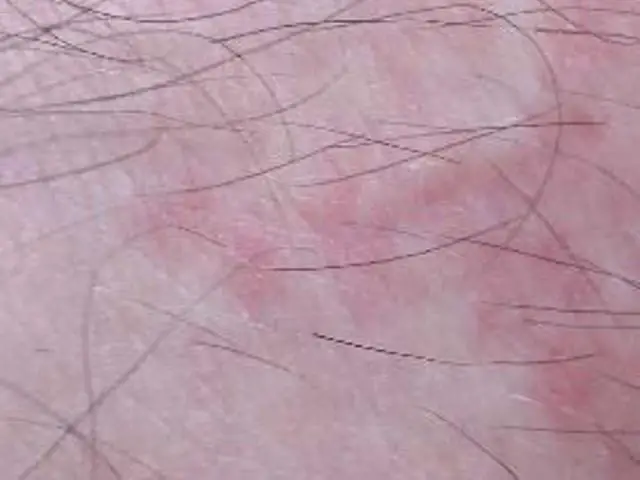 Bed bug bite skin reaction after 30 minutes Bed bug bite skin reaction after 30 minutes |
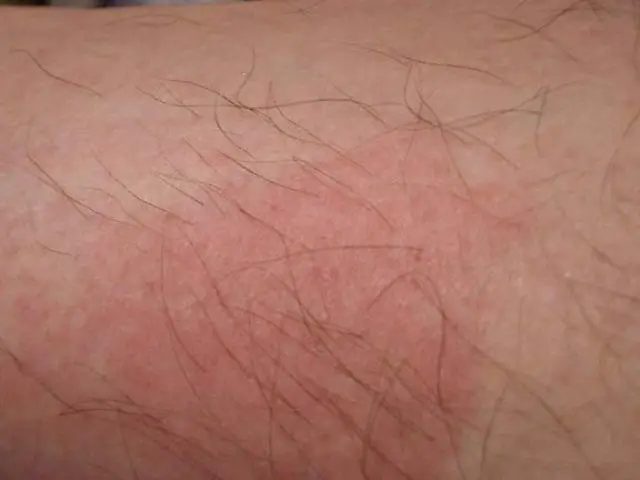 Bed bug bite skin reaction after 48 hours Bed bug bite skin reaction after 48 hours |
Bite Patterns
Bed bug bite patterns such as three bites in a triangle or 3 bites in a row or line occur when the bed bug is feeding and is then disturbed by movement. After the movement stops the bed bug continues to feed.
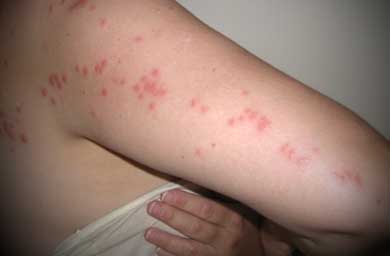 Bites In A Line On Arm That Usually Occur Along A Blood Vessel Near the Skin Surface
Bites In A Line On Arm That Usually Occur Along A Blood Vessel Near the Skin Surface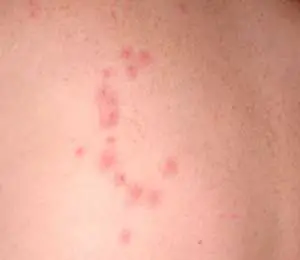 Bed Bug Bites In a Circle Pattern On Back
Bed Bug Bites In a Circle Pattern On Backwe suggest contacting a pest control expert
There are many types of non-chemical and chemical based methods used to get rid of bed bugs. There are also several organic products available. that can be effective when used in combination with non-chemical approaches.
We always suggest starting with a home inspection by a pest control company. A national network such as Home Advisor is a good place to start. Make sure to get multiple quotes from different pest control experts.
You can also check our database of local contractors which can be searched by entering your zip code here. Any contractor would be happy to answer questions regarding what are bed bugs and how to deal with a bed bug infestation.
bedbug infestations- products required and treatment at home
When treating a bed bug infestation yourself, multiple products are needed to do a thorough job, it can be hard to find bed bugs. They hide in between cracks and crevices, mattresses, box springs bed frames and many other places. All of the products suggested below are effective in killing bedbugs:
There are kits available that contain the required products for bed bug treatment.
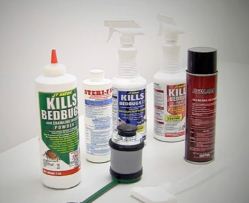 Kit From Bed Bug Supply Containing the Required Products for Home Treatment
Kit From Bed Bug Supply Containing the Required Products for Home TreatmentInsecticide based approaches are also available in helpful kits. We suggest a bedbug kit that contains a "Knock down" spray (Sterifab), a residual spray to lasting protection against bed bugs (Bedlam or Phantom), and bed bug dust.
Click here for step by step instructions on how to get rid of bed bugs. If you have any questions regarding what are bed bugs, just search this site or drop us a note below.
Ask a Question or Share Your Bed Bug Experience With Others
Do you have a question or great story about bed bugs? Share it!
